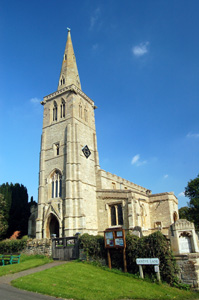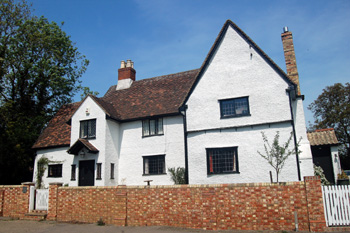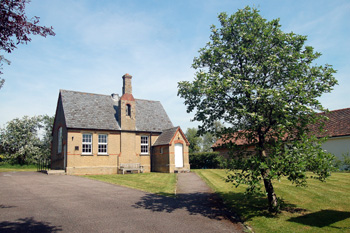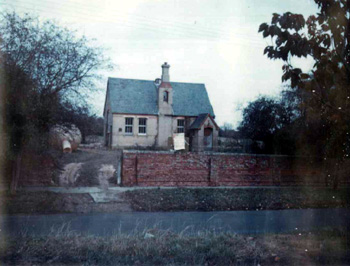
Swineshead church from the south-west, September 2008
Volume 81 published by Bedfordshire Historical Records Society (2002) is a series of episcopal visitations undertaken by the Bishop of Lincoln in the first twenty years of the 18th century, edited by former County Archivist Patricia Bell. At each visitation a list of questions was sent out in advance, one of which enquired about the provision of schools in each parish. The volume includes returns for Swineshead, then in Huntingdonshire, and so the Archdeaconry of Huntingdon, for the years 1706, 1709 and 1712. In 1706 it was reported "There is no Lecture, School, or Almes-house within the Parish", education is not mentioned in the returns of 1709 and 1712.
In 1717, 5 boys from Swineshead were taught in a Charity School in Dean. They learned reading, writing and arithmetic. Joseph Neal had established this school in 1702 and it taught ten poor boys from Dean, five from Shelton and five from Swineshead.
By 1818 there was a Sunday school which was attended by 40 children. The costs involved in running the school were met by the parish. John Bligh, the curate, felt that the Sunday school and the fact that 5 children could attend school in Dean meant that the ‘poor have the means of education.’ In those days a Sunday School meant just that, a school which met on a Sunday and it taught such things as reading and writing as well as the religious elements solely associated with the term today.
An Infant school was started in 1827; it contained 9 girls and 9 boys who were partly paid for by their parents and were also supported by Lady Mandeville. She also provided the coal to heat the school. This it possible that this may, from the later name of the dwelling, have met in what is now called The Old Schoolhouse although without written evidence this can only be pure conjecture. A Sunday school of 16 boys and 10 girls was supported by the rector and the churchwardens.

The Old School House, May 2008
The Swineshead vestry minutes record estimates for building a school in 1870 [ref: P96/8/1] but it was not actually built for five years. It is not clear whether the school was a National School, a Church School unaffiliated with the National Society or a non-denominational school. It was supported by contributions and five boys had free places as a result of Neale's Charity of Dean, as described in Kelly's Directory.
The first entry in the school log book [ref: SDSwineshead1/1], for 6th October 1875, reads: "Commenced School on Monday morning. 44 children present. Arranged them in four classes. Most of them have never been to School at all. Arithmetic is the worst feature at present". On 15th October the entry read: "Commenced teaching needlework this week to a class of 24 girls. The elder ones know something of it having been taught at home". The entry for 19th October reveals that attendance was not so rigorous as today: "The attendance at School was not so good this morning in consequence of rain".

The Old School, May 2008
School life and lessons were affected by contemporary events such as the Boer War as these entries from the log book show:
- 28th February 1900: "Hung up map from Union Line Co. illustrating routes to South Africa with picture of ship. Children earnestly interested on account of the war".
- 31st May 1900: "Half-holiday given on receipt of news announcing surrender of Pretoria".
A land mark Education Act was passed in 1902, coming into effect in 1903. It established Local Education Authorities, usually the county council, as in Bedfordshire. Former Board Schools became Council Schools whilst the old National, British and other non-Board schools became known as Public Elementary Schools, as was the case with Swineshead.
Bedfordshire Archives has a scrapbook of cuttings of visits made to most Bedfordshire Schools by School Inspectors for a period from just before the First World War through the inter-war years [ref: E/IN1/1].The first report in the volume is for 1909 and the inspector commented: "The condition of this school leaves much to be desired but the late teacher left it in an unsatisfactory state. Considerable improvement will be expected in future. The periodical examinations by the headteacher are not properly conducted. The managers should see that these examinations, if held, are reliable tests of the progress of the children. At present this is not the case".
Four years later, when average attendance was 28, the inspector reported: "The school when last reported upon was in an unsatisfactory condition and, owing to adverse circumstances, little, if any improvement has been effected. Order and tone are good, but the attainments of the children are much below those of similarly situated schools in the area. The present Mistress, who has not been long in charge, has, however, made a good beginning. Sounder methods and more thorough and intelligent instruction now obtain and there is reason to believe that the school will be soon raised to a more satisfactory level of efficiency". The following year the inspector was happy to report: "This school which was in a low state of efficiency when the present Mistress took charge, has greatly improved. Order and tone are excellent, the instruction is skilfully and sympathetically given and the children have made marked progress during the past year".
The next inspection did not take place until after the First World War, in 1919: "Even after full allowance for the effect of closures and bad attendance has been made, the progress of the children in this small school cannot be considered at all satisfactory. There is no doubt that the teacher works conscientiously and has done her best to make the school efficient, but she seems to find it difficult single-handed to teach several groups old older children and infants without giving so much assistance as to make the children helpless, and this probably accounts for the unsatisfactory progress. In such a school either an assistant should be provided to take charge of the younger children or children under 5 years of age should not be admitted. Whichever course is adopted, it should be clearly understood that the work of the school must improve".
The next visit, in 1921, revealed that some steps had been taken: "Since the last report the Writing and Composition of the older children have improved and are now quite creditable, and their Arithmetic is also somewhat better. Their knowledge of Geography and History, however, is very slight, and Reading remains weak throughout the School. It is clear that some alterations in teaching these subjects is needed. Drawings with pastels is exceedingly good, and the Handiwork also, but subjects shewing what beautiful work village children can do in the hands of a teacher possessing artistic ability. Although children under five years of age are not now admitted, and although the older scholars are more self-dependent than used to be the case, the Mistress still finds some difficulty in dealing with so many groups of children without assistance".
Two visits were made in 1925, when average attendance was 22. The first, on 16th January, the inspector finding that: "The general condition of this school has not changed much since the last Report was made". The second visit was on 12th March and dealt solely with the premises: "There are some badly broken down-pipes, and defective guttering which should be repaired, and the slates missing from the corners of the roof should be replaced. The offices and urinal are badly kept and need lime washing. The hinge in the door and the hole in the roof on the boys' side should be repaired. There is dry rot in the woodwork of most of the windows. The Porch cloak-room is too small for its purpose and is not adequately ventilated. The Heating is insufficient: the temperature chart shows that only 12 times between January 6th and March 10th has the thermometer rise slightly above 50. The surface of the playground is in deplorable condition. The grass has practically disappeared and the playground is simply an expanse of clinging mud which becomes deep slush on the way to the offices. It is, in its present condition, unfit to be used for play and absolutely unsuitable for Physical Exercises. The wire fence is broken down also. All these points should receive the serious attention of the Managers".

The Old School in the 1970s [ref: PL/PH8/11/2]
This was the last Inspector's report as the school closed in 1925 and the pupils were transferred to Pertenhall and Riseley [ref: P96/29/4]. The premises were put in good repair and used as a village hall, run by a committee until 1963 when the Parochial Church Council took over its running [ref: P96/35/1/5].
List of sources at Bedfordshire Archives:
- AD3865/42/1: Site plan of school, 1875
- SDSwineshead: Swineshead School Records, 1875-onwards
- P96/29/2: Bundle of vouchers to school accounts, 1903-1905
- P96/29/3: School account book, 1905-1915
- P96/29/4: Correspondence and papers concerning the closure of Swineshead Church of England school, 1925
- Z50/120/4: Photograph of Swineshead School, 1935
- P96/35/1/5: Notes on the status of the old school, 1963-1970
- P96/35/1/7: Correspondence and papers concerning the deeds to the school premises, 1974-1975